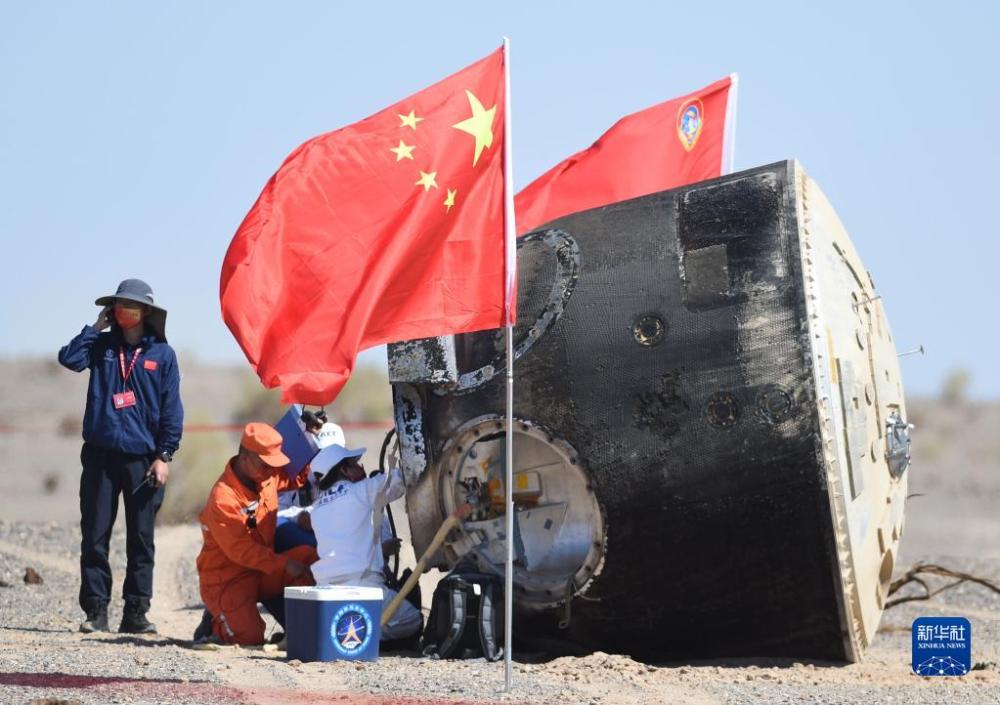Science
Chinese astronauts return with first mission for space station construction accomplished – CCTV
— Having worked in the space station core module Tianhe for three months — the longest-ever human space mission in Chinese history, three astronauts of the Shenzhou-12 crew returned to Earth on Friday, hitting a new milestone in China’s space exploration.
BEIJING, Sept. 17 (Xinhua) — Three Chinese astronauts, the first sent to orbit for China’s space station construction, have completed their three-month mission and returned to Earth safely on Friday.


The return capsule of the Shenzhou-12 manned spaceship, carrying astronauts Nie Haisheng, Liu Boming and Tang Hongbo, touched down at the Dongfeng landing site in north China’s Inner Mongolia Autonomous Region at 1:34 p.m. (Beijing Time).
The first manned flight during the construction of China’s space station was a complete success, the China Manned Space Agency (CMSA) announced.
The return capsule of Shenzhou-12 separated from the spaceship’s orbiting capsule at 12:43 p.m. under the command of the Beijing Aerospace Control Center. The braking engine of the return capsule then ignited, and the return capsule separated from the propelling capsule.
After the return capsule landed successfully, the ground search team arrived at the landing site. This is the first time that the Dongfeng landing site was used in the search and retrieval of the manned spacecraft. The medical personnel confirmed that the astronauts were in good health, after the hatch of the return capsule was opened.
The trio looked relaxed and waved to the ground crew after they exited the return capsule. Later, they were escorted to a helicopter by the ground crew, according to Xinhua reporters at the scene.
“Welcome back home for the Mid-Autumn Festival,” the people cheered as the country’s space heroes passed by.
The Mid-Autumn Festival, a traditional event symbolizing family reunion, falls on Sept. 21 this year.
The three astronauts arrived at Beijing by plane Friday night, but they will not go immediately back home to celebrate the festival with their families. Instead, they will undergo several weeks of quarantine for a comprehensive medical examination and health assessment, according to Xu Wenlong, a research assistant with the China Astronaut Research and Training Center.
The professional medical personnel will help the astronauts re-adapt to the gravity and environment on Earth, restore their body functions as soon as possible and improve their immunity, through multiple methods of exercise, diet, massage, physical therapy, and treatment with traditional Chinese medicine, Xu said.


The success of the Shenzhou-12 manned spaceflight mission laid a solid foundation for the continued construction and operation of the country’s space station, the CMSA said.
On June 17, the Shenzhou-12 spaceship was launched from the Jiuquan Satellite Launch Center in northwest China and docked with the space station core module Tianhe. After the docking, the three astronauts entered the core module and began their three-month stay in space.
On June 23, Chinese President Xi Jinping held a video talk from the Beijing Aerospace Control Center with the astronauts, showing his consistent concern and support for the Chinese pursuit of its space dream.
“The construction of the space station is a milestone in China’s space industry, which will make pioneering contributions to the peaceful use of space by humanity,” said Xi, also general secretary of the Communist Party of China Central Committee and chairman of the Central Military Commission.
The Shenzhou-12 crew carried out a series of space science and technology experiments, and tested key technologies for the construction and operation of the space station, concerning long-term stays by astronauts, the recycling and life-support system, the supply of space materials, extravehicular activities (EVAs) and operations, and in-orbit maintenance.
They performed EVAs twice, on July 4 and Aug. 20, respectively.
The first EVAs, performed by Liu Boming and Tang Hongbo, took approximately seven hours. The astronauts accomplished tasks including equipment installation and panoramic camera lifting.
Nie Haisheng and Liu Boming carried out EVAs for the second time, installed extravehicular extended pump sets and lifted a panoramic camera in about six hours of EVAs.
The EVAs tested the performance and function of the new-generation homemade extravehicular mobility units and the coordination between the astronauts and the mechanical arm, as well as the reliability and safety of related EVA supporting equipment.
The mechanical arm installed on the core module played an important role in assisting the astronauts with their EVAs.
It is designed to help the astronauts in the assembly, construction, maintenance and repair of the space station, and to support space applications.
China launched its space station core module Tianhe on April 29 and the cargo craft Tianzhou-2 on May 29. The two completed a computer-orchestrated rendezvous and docking on May 30.
The Shenzhou-12 spaceship then formed a three-module complex with the combination of Tianhe and Tianzhou-2 after it was launched.
The Tianzhou-3 cargo craft and the Shenzhou-13 manned spaceship will also be launched later this year to dock with Tianhe, and another three astronauts will then begin their six-month stay in orbit.
After the five launch missions this year, China plans to have six more missions, including the launch of the Wentian and Mengtian lab modules, two cargo spacecraft and two crewed spaceships, in 2022, to complete the construction of the space station.
Science
Local astronomer urges the public to look up – Windsor News Today – windsornewstoday.ca

If last week’s solar eclipse piqued your interest in astronomy, the Royal Astronomical Society of Canada’s Windsor Chapter plans to show off some of the more dramatic photos and videos members took of the event.
They were stationed along the path of totality along the northern shore of Lake Erie and in the U.S.
“People did take some nice photos with their cellphones, but we have members who took photos and videos with their telescopes,” said member Tom Sobocan. “You’ll see some pretty impressive shots.”
About 100 members are in the local chapter, which meets every third Tuesday of every month.
Thursday’s meeting is at the Ojibway Nature Centre on Matchette Road. It starts at 7:30, and it’s open to the public. Seating is limited, so Sobocan recommends arriving early.
Astronomers are looking ahead to new wonders in the heavens. Right now, the Pons-Brooks Comet, another once-in-a-lifetime opportunity, is approaching Jupiter in the constellation of Aries.
“If you’re in a dark-sky location, you can see it with the naked eye, and from inside the city, you can see it with binoculars,” said Sobocan. “It may get a little bit brighter going towards the fall, but our members have already photographed it with their telescopes.”
It’s a periodic comet which appears in the night sky once every 71 years.
Sobocan said once-in-a-lifetime events, like last week’s eclipse, inspired many of its existing members, but he hopes some new ones will join the group.
“I hope it inspires them to look up at the sky a little bit more often and realize that everything’s in motion in the sky,” he said. “It’s not stationary.”
Science
Giant, 82-foot lizard fish discovered on UK beach could be largest marine reptile ever found – Livescience.com


Scientists have unearthed the remains of a gigantic, 200 million-year-old sea monster that may be the largest marine reptile ever discovered.
The newfound creature is a member of a group called ichthyosaurs, which were among the dominant sea predators during the Mesozoic era (251.9 million to 66 million years ago). The newly described species lived during the end of the Triassic period (251.9 million to 201.4 million years ago).
Ichthyosaurs had already attained massive sizes by the early portion of the Mesozoic, but it was not until the late Triassic that the largest species emerged.
While the Mesozoic is known as the age of the dinosaurs, ichthyosaurs were not themselves dinosaurs. Instead, they evolved from another group of reptiles. Their evolutionary path closely mirrors that of whales, which evolved from terrestrial mammals that later returned to the sea. And like whales, they breathed air and gave birth to live young.
The newly discovered ichthyosaur species was unearthed in pieces between 2020 and 2022 at Blue Anchor, Somerset in the United Kingdom. The first chunk of the fossil was noticed atop a rock on the beach, indicating that a passerby had found it and set it there for others to examine, the researchers explained in the paper. The researchers published their findings April 17 in the journal PLOS One.
The reptile’s remains are made up of a series of 12 fragments from a surangular bone, which is found in the upper portion of the lower jaw. The researchers estimate the bone was 6.5 feet (2 meters) long and that the living animal was about 82 feet (25 m) long.
The researchers named the sea monster Ichthyotitan severnensis, meaning giant lizard fish of the Severn, after the Severn Estuary where it was found. The team believes it is not only a new species but an entirely new genus of ichthyosaur. More than 100 species are already known.
window.sliceComponents = window.sliceComponents || ;
externalsScriptLoaded.then(() => {
window.reliablePageLoad.then(() => {
var componentContainer = document.querySelector(“#slice-container-newsletterForm-articleInbodyContent-5Tm52KifRnJsTxFt8noX8R”);
if (componentContainer)
var data = “layout”:”inbodyContent”,”header”:”Sign up for the Live Science daily newsletter now”,”tagline”:”Get the worldu2019s most fascinating discoveries delivered straight to your inbox.”,”formFooterText”:”By submitting your information you agree to the Terms & Conditions and Privacy Policy and are aged 16 or over.”,”successMessage”:”body”:”Thank you for signing up. You will receive a confirmation email shortly.”,”failureMessage”:”There was a problem. Please refresh the page and try again.”,”method”:”POST”,”inputs”:[“type”:”hidden”,”name”:”NAME”,”type”:”email”,”name”:”MAIL”,”placeholder”:”Your Email Address”,”required”:true,”type”:”hidden”,”name”:”NEWSLETTER_CODE”,”value”:”XLS-D”,”type”:”hidden”,”name”:”LANG”,”value”:”EN”,”type”:”hidden”,”name”:”SOURCE”,”value”:”60″,”type”:”hidden”,”name”:”COUNTRY”,”type”:”checkbox”,”name”:”CONTACT_OTHER_BRANDS”,”label”:”text”:”Contact me with news and offers from other Future brands”,”type”:”checkbox”,”name”:”CONTACT_PARTNERS”,”label”:”text”:”Receive email from us on behalf of our trusted partners or sponsors”,”type”:”submit”,”value”:”Sign me up”,”required”:true],”endpoint”:”https://newsletter-subscribe.futureplc.com/v2/submission/submit”,”analytics”:[“analyticsType”:”widgetViewed”],”ariaLabels”:;
var triggerHydrate = function()
window.sliceComponents.newsletterForm.hydrate(data, componentContainer);
if (window.lazyObserveElement)
window.lazyObserveElement(componentContainer, triggerHydrate);
else
triggerHydrate();
}).catch(err => console.log(‘Hydration Script has failed for newsletterForm-articleInbodyContent-5Tm52KifRnJsTxFt8noX8R Slice’, err));
}).catch(err => console.log(‘Externals script failed to load’, err));
A number of rib fragments and a coprolite, or fossilized feces, were found in the area as well, but they were not definitively attributed to the same animal.
The sediments in which these specimens were found contained rocks that indicated earthquakes and tsunamis occurred during that time, which suggests that this species lived during a time of intense volcanic activity that may have led to a massive extinction event at the end of the Triassic according to the researchers.
A similar specimen was discovered in Lilstock, Somerset in 2016 and described in 2018. Both were found in what is known at the Westbury Mudstone Formation, within 6 miles (10 kilometers) of each other. This ichthyosaur was estimated to have been as much as 85 feet (26 m) long, although the authors of the latest study believe it was slightly smaller.
The previous contender for the largest marine reptile was another ichthyosaur, Shonisaurus sikanniensis, which was up to 69 feet (21 m) long. S. sikanniensis appeared 13 million years earlier than I. severnensis and was found in British Columbia, making it unlikely that the new discovery represents another specimen of the previously known species.
A similarly massive ichthyosaur called Himalayasaurus tibetensis, which may have reached lengths of 49 feet (15 m), was discovered in Tibet and described in 1972. It dates to the same period, meaning that it probably is not the same species as the new discovery either.
I. severnensis was likely among the last of the giant ichthyosaurs, the researchers claim. Ichthyosaurs persisted into the Cenomanian Age (100.5 million to 93.9 million years ago) of the late Cretaceous period (100.5 million to 66 million years ago). They were eventually supplanted by plesiosaurs — long-necked marine reptiles that went extinct at the end of the Cretaceous, alongside all non-avian dinosaurs.
Science
Federal government announces creation of National Space Council | RCI – Radio-Canada.ca


- Home
- Politics
- Federal Politics
The Canadian Space Agency also received a proposed $8.6 million for its lunar program
Nicole Mortillaro (new window) · CBC News
Canada’s space sector received a boost from the federal government in its budget, both in terms of money and vision.
The 2024 budget (new window) included a proposal for $8.6 million in 2024-25 to the Canadian Space Agency (CSA) for the Lunar Exploration Accelerator Program (new window) (LEAP), which invests in technologies for humanity’s return to the moon and beyond.
In addition to the funding, the federal government also announced the creation of a National Space Council, which will be a new whole-of-government approach to space exploration, technology development, and research.
For Space Canada (new window), an organization comprised of roughly 80 space sector companies including some of Canada’s largest, such as Magellan Aerospace (new window), Maritime Launch (new window) and MDA Space (new window), it was a welcome announcement.
We’ve been advocating for it since the inception of our organization, and we were really very happy, and we applaud the federal government’s commitment announced in the budget,
said Brian Gallant, CEO of Space Canada.
Gallant said that investment in space is an investment in Canada.
Two-thirds of space sector jobs are STEM jobs. These are good paying solid jobs for Canadians. And on top of that, we have approximately $2.8 billion that is injected into the Canadian economy because of the space sector,
he said.
The U.S. formed its National Space Council in 1989, but it was disbanded in 1992 and reestablished in 2017.
In the 2023 budget (new window), the government announced proposed spending of $1.2 billion over 13 years, that was to begin in 2024-25, to the CSA’s contribution of a lunar utility (new window) vehicle that would assist astronauts on the moon. The as–yet–developed vehicle could help astronauts move cargo from landing sites to habitats, perform science investigations or support them during spacewalks on the surface of the moon.
It also proposed to invest $150 million over five years for the LEAP program.
MDA Space, the company behind Canadarm, was also pleased with the announcement.
Canada has an enviable global competitive advantage in space and the creation of a National Space Council is critical to Canada maintaining that leadership position,
CEO Mike Greenley said in an email to CBC News.
Space is now a rapidly growing, highly strategic and competitive domain, and there is a real and urgent need to recognize its importance to the lives of Canadians and to our economy and national security.
The next project for MDA is Canadarm3, which will be part of Lunar Gateway, a international space station that will orbit the moon. It will serve as a sort of jumping-off point for astronauts heading to the moon and eventually beyond.
The Lunar Gateway is a great opportunity for Canada and for MDA Space to not only provide the next generation of Canadarm robotics but to clearly plant our flag as a core national and industry participant in the Artemis era,
Greenley said.
Lunar Gateway is set to begin construction no earlier than 2025 (new window), according to NASA.
-
News21 hours ago
Loblaws Canada groceries: Shoppers slam store for green onions with roots chopped off — 'I wouldn't buy those' – Yahoo News Canada
-
Investment20 hours ago
Saudi Arabia Highlights Investment Initiatives in Tourism at International Hospitality Investment Forum
-
Business20 hours ago
Rupture on TC Energy's NGTL gas pipeline sparks wildfire in Alberta – The Globe and Mail
-
Art20 hours ago
Squatters at Gordon Ramsay's Pub Have 'Left the Building' After Turning It Into an Art Café – PEOPLE
-



 Tech13 hours ago
Tech13 hours agoCytiva Showcases Single-Use Mixing System at INTERPHEX 2024 – BioPharm International
-



 Sports23 hours ago
Sports23 hours agoGame in 10: Maple Leafs squander multi-goal lead to Florida, draw the Boston Bruins in the first round – Maple Leafs Hot Stove
-



 Politics20 hours ago
Politics20 hours agoThe Earthquake Shaking BC Politics
-



 Science21 hours ago
Science21 hours agoFederal government announces creation of National Space Council – CBC News








